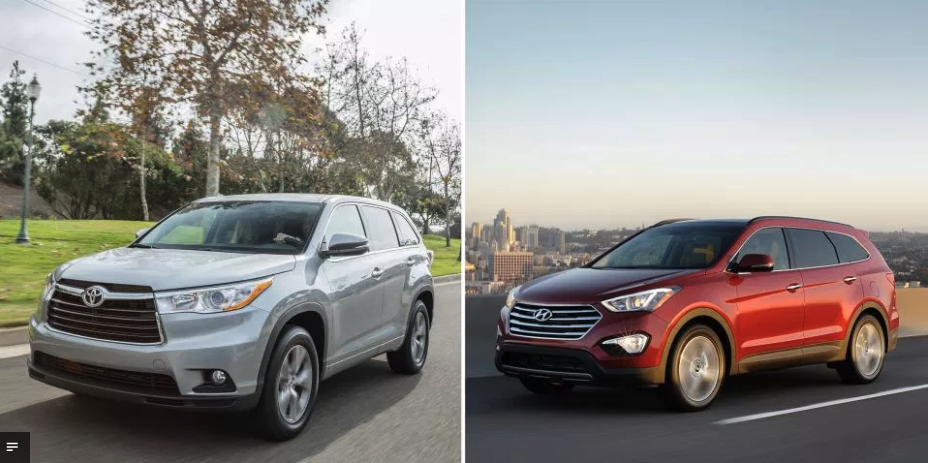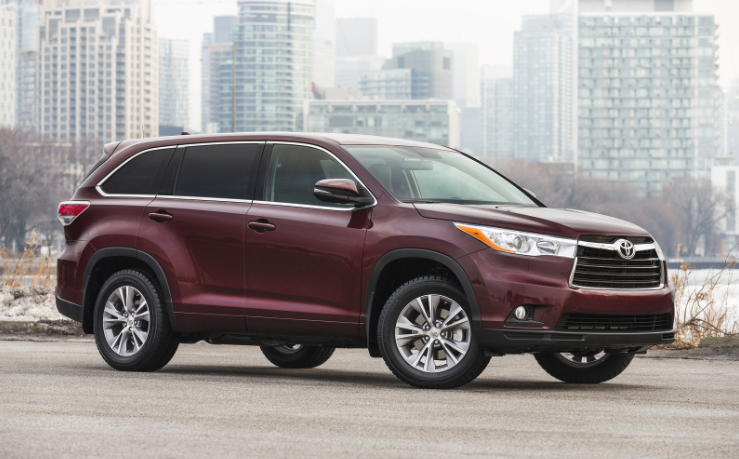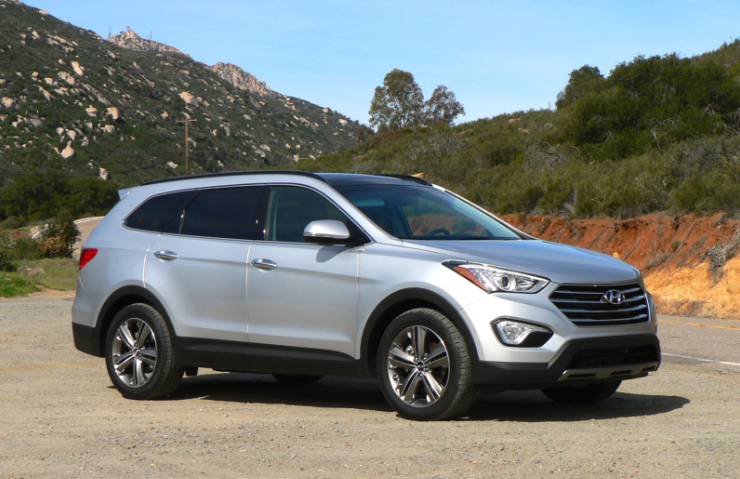Comparison Test: 2014 Hyundai Santa Fe XL versus Toyota Highlander

Story by John LeBlanc
Most new car buyers are expecting some sort of compromise with their next purchase. Two-seat sports car buyers will more than likely have their larger Ikea purchases delivered to their homes. In the same vein, pickup truck owners won’t be entering their local motorsport club’s Sunday slalom event.
But then there are today’s crossover buyers. This no-compromise bunch expects the seating capacity of a minivan, the economy of a family sedan and the all-weather capabilities of a four-wheel-drive SUV — all wrapped up in one vehicle.
So we brought together the all-new-for-2014 Toyota Highlander and the new-last-year Hyundai Santa Fe XL to find out which one was the least compromised crossover.

FIRST PLACE: 2014 Toyota Highlander LE AWD
Long due for a makeover (the outgoing model had been around since 2007), the new, third-generation Toyota Highlander four-door, three-row crossover is bigger, roomier and more functional than ever.
Despite their over-generous capabilities, both of these three-row crossovers cost like well-equipped V6 family sedans. The base, front-wheel-drive, eight-seat 2014 Highlander LE starts at $33,665 (all prices include freight and pre-delivery inspection fees). The topline, seven-seat Highlander Limited AWD starts at $47,085. But we think most buyers will opt for the $36,165 LE AWD eight-seater model.
Proving how competitive this segment is, the powertrain specs for the Hyundai and Toyota are nearly identical. Both sport six-cylinder gas engines: the Santa Fe XL’s displacing 3.3 litres, and the Highlander 3.5. The Toyota is rated at 270 horsepower and 248 pound-feet of torque, while the Hyundai’s numbers are 290 and 252, respectively. Both vehicles also employ automatic transmissions with six gears.
While the Toyota’s powertrain lived up to its expected smoothness and refinement, it was the way the big crossover went down a twisty road that surprised us the most. Compared to the Santa Fe XL, the Highlander turns into corners quicker, keeping its body motions in check. Sure. Understeer is omnipresent. But the Toyota’s handling won’t surprise its driver. And despite its composed road manners, the Highlander still delivers a smoother ride than the Hyundai. The only driving demerit is numb steering.
Passengers — arguably the higher priority occupants in this type of vehicle — also benefit greatly in the new Highlander.
First off, the front cabin design has a plethora of handy storage compartments, from the large centre console box to the wide storage shelf that sits underneath the centre dash. Wider than the Hyundai, the Toyota also offers the more overall room (with its second- and third-row seats down, there’s 2,370 litres of cargo room, 105 more than the Santa Fe XL) plus one more seat in the 60/40 split back row.
Overall, with its more car-like driving characteristics and roomier and more functional cabin, we think the 2014 Toyota Highlander LE AWD is the better pick for uncompromising crossover buyers.

SECOND PLACE: 2014 Hyundai Santa Fe XL
When the time came for Hyundai to design a new three-row crossover last year, its lesser-known Veracruz nameplate disappeared in favour of literally expanding its two-row Santa Fe family with the introduction of the three-row XL model.
Arguably, the $32,894 front-wheel-drive base, seven-seat Santa Fe XL is there for buyers looking to a replace a minivan, as the rest of the lineup (all the way to the six-seat $45,294 Santa Fe XL Limited) comes with all-wheel-drive as standard kit. The seven-seater $36,894 Santa Fe XL Premium AWD best matches the Highlander LE AWD rival in price.
Despite having more horsepower, the Santa Fe XL and Toyota Highlander share nearly identical performance numbers. Both three-row crossovers scoot from 0 to 100 kilometres per hour in 7.5 seconds. And the estimated fuel economy ratings for the Hyundai and Toyota (11.8/11.5 L/100 kms city; 8.0/8.2 highway) are real world ties, and both share a tow rating of 2,268 kilograms (5,000 lb).
Except for the Santa Fe XL Limited (which comes exclusively with a pair of captain’s chairs in its second-row to make it a six-seater) all models offer 2+3+2 seating. Pre-teen children will be fine back in the 50:50-split folding third row thrones — and yielding adults. But keep in mind the roomier Highlander offers 2+3+3-seating.
While the Hyundai may not be as much fun to drive nor as spacious and functional as the Toyota, it certainly trumps it when it comes to standard equipment. On top of the base Santa Fe XL FWD’s heated front seats, and six-speaker audio system, the Premium model adds features like heated second-row seats, heated steering wheel and a 12-way powered driver’s seat — items that would push the Toyota’s price into the plus-$40k range.
If you’re a sucker for some of the luxury goodies it offers over the Toyota for similar money—and don’t need that extra rear seat—it’s hard not to say “no” to the 2014 Hyundai Santa Fe XL Premium.




